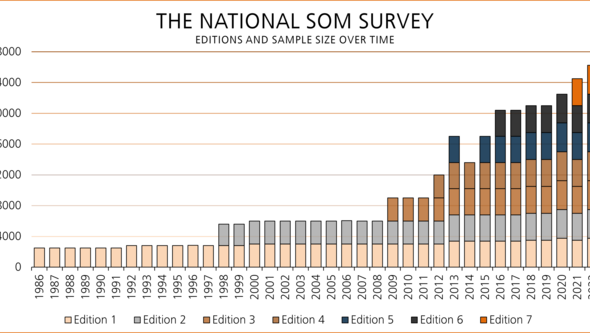
Method
How are the SOM surveys conducted? This page has all the answers.
In order for the results to be as comparable over time as possible, it is vital for the SOM surveys to follow the same general methodological procedure every year. Even though the surveys themselves have grown over the years in terms of editions and sample size, the surveys are conducted in much the same way now as they were at the start in 1986.
Probability samples
Each year in September a random selection of people listed as living in Sweden between the ages of 16 and 90, is drawn from the national Tax Agency register. This is what is referred to as the sample, and because it is large enough, as well as completely random, the sample itself is considered representative for the entire population: people living in Sweden between 16 and 90. For the national SOM survey, the total sample was only 2800 people in 1986, but in 2023 the total sample size was 26 250 swedes.

The information from the register provides the SOM institute with the names, ages and addresses of the people in the sample. These people then receive information, as well as the survey itself, by standard mail to their home. During the following months they will also receive a series of reminders by mail and possibly even by text message. The survey can be answered either by filling out the physical questionnaire, or by logging on to a digital platform using a code provided with the survey.
Response rates and representativity
Net response rates for the national SOM surveys are usually around 50 percent, meaning that roughly half of those randomly selected to participate actually take part in the survey. Considering the fact that the individuals chosen haven't asked to take part in any survey, and occasionally can not even be reached at their official addresses, 50 percent response rate is deemed very high for a survey of this nature. However, in the late 80:s and early 90:s, response rates could be as high as 70 percent.
Of course, missing out on the opinions and views of roughly half of the sample has implications for the representability of the survey results. Analyses show similar patterns each year: to a certain degree, the SOM surveys fail to collect data from certain groups - most notably people with low political interest, low trust in authorities and researchers, people who are between 20-30 years old, people with less stable life situations and people who were born outside of Europe. This of course has to do with many factors making such groups both harder to reach with standard mail and less interested in taking part in academic surveys. General groups who tend to reply more often than their counterparts are older people, people who are married, people with higher educations and women.
Occasionally, statistical weighing can be used to determine for what variables the lack of certain participants actually matter for the outcome. For instance, due to overrepresentation of older people with stable household situations, the SOM surveys show an inflated percentage for morning paper subscriptions. Researchers working with variables regarding media habits for example, are very much informed about these possible biases. Read more about this in our latest Method report for the national SOM survey (Swedish).
Survey questionnaires
The questionnaires themselves contain questions about attitudes and opinions regarding different subjects, but also questions about lifestyle, habits and general demography of the respondents. Many of the questions are part of the SOM Institute's own long term research about Swedish society, but a large number of questions are asked in collaboration with specific research projects or Swedish public organizations. Questionnaires today are generally about 10-12 pages long and take about 40 minutes to fill out.
Survey questions are currently in Swedish only, which of course is a contributing factor to the slight lack of representativity among people born outside of Sweden. Some data is translated into English however, and made available in our SOM Institute Cumulative Dataset, read more under Data. Results are occasionally presented in English as well, most notably in the report Swedish trends.
